Recipes
Baby Food Recipes: Simple and Nutritious Meals
Intrigued by the idea of homemade baby food? Learn how to create simple and nutritious meals that your little one will love.

When you're seeking simple and nutritious meals for your baby, consider starting with homemade options. Introduce soft or pureed choices at the age of 6 months, focusing on iron-rich foods like egg yolk and liver. Opt for nutrient-dense options such as sweet potatoes and butternut squash as best first foods. Progress to textures and flavors around 9 months, offering dishes like flaky salmon and roasted vegetables. Boost independence with finger foods like fruits and pasta, promoting self-feeding skills. Guarantee food safety by cooking items thoroughly and storing them correctly. If you explore further, you'll discover essential tips for making homemade baby food.
Key Takeaways
- Start with nutrient-dense foods like sweet potatoes and butternut squash for simple and nutritious options.
- Incorporate iron-rich foods such as egg yolk and liver to prevent anemia in babies.
- Offer a variety of flavors and textures by transitioning from purees to soft solids.
- Introduce finger foods for independence and exploration, promoting self-feeding skills.
- Store homemade baby food in sealed containers in the fridge for short-term use and freeze unused portions for longer storage.
Starting Solid Foods
When your baby is around 6 months old and displaying signs of readiness, it's time to start introducing solid foods. This stage is important for your baby's development as they move from a milk-only diet to more diverse options.
Homemade baby food is a great choice during this period, offering nutrient-dense options that you can tailor to your baby's needs. By making your own baby food, you have control over the ingredients, ensuring that your little one receives essential nutrients without added preservatives or sugars.
As you begin this journey of starting solid foods with your baby, remember to start with soft or pureed options to make it easier for them to eat. Iron-rich foods like egg yolk, liver, and pureed meats are excellent choices to introduce first, helping to prevent anemia in babies.
It's important to introduce new foods gradually and watch out for any signs of allergies or sensitivities as your baby explores different flavors and textures.
Best First Foods for Babies

To introduce your baby to solid foods, consider starting with iron-rich options like egg yolk and liver, ideal for preventing anemia and supporting their growth and development.
When choosing foods for your little one, opt for nutrient-dense options that are gentle on their developing digestive system.
Some excellent first foods for babies include:
- Sweet Potatoes: Rich in essential vitamins and minerals, sweet potatoes are easy to digest and offer a naturally sweet flavor that babies tend to enjoy.
- Butternut Squash: Packed with nutrients like beta-carotene and vitamin C, butternut squash is a great choice for introducing vegetables into your baby's diet.
- Baby Led Weaning: This approach encourages self-feeding and the exploration of different textures, helping babies develop their motor skills and taste preferences.
Transitioning at 9 Months

Consider broadening your baby's palate at 9 months by introducing:
- Flaky salmon
- Ground beef
- Roasted vegetables
- Baked potatoes
- Pasta dishes
These foods for babies can provide a variety of flavors and textures to keep your little one engaged during mealtime. Incorporating finger foods like banana slices and well-cooked pasta can also help promote independent eating skills through baby-led weaning.
When preparing meals, focus on flavor combinations using wholesome ingredients. Fresh herbs and spices can add depth to your baby's dishes without the need for added salt or sugar. Remember to introduce new flavors gradually, keeping an eye on your baby's tolerance level.
As you progress at 9 months, encourage exploration of different tastes while ensuring a balanced diet.
Introducing Textures and Flavors
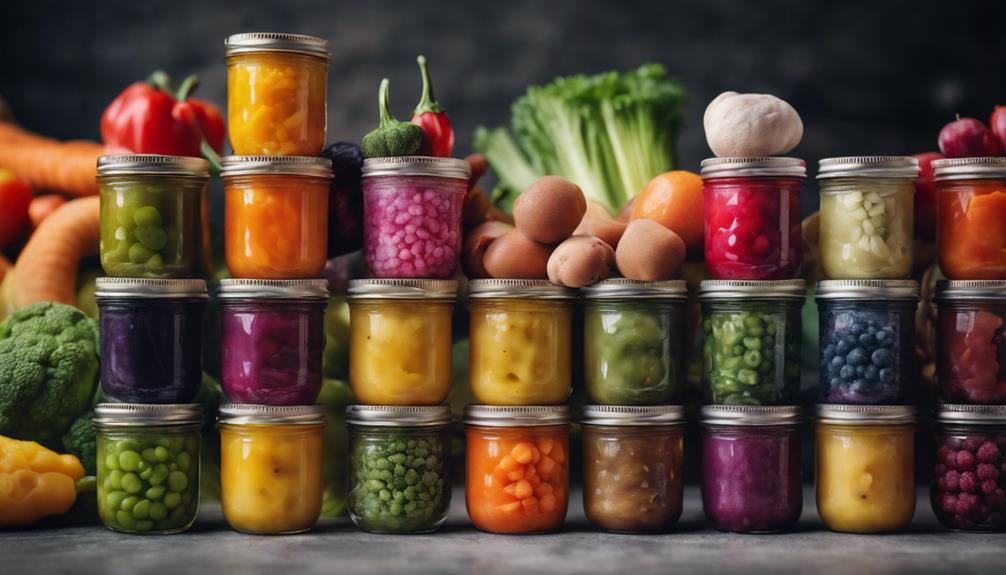
Enhance your baby's culinary journey by gradually introducing a variety of textures and flavors to aid in developing their taste preferences and fostering healthy eating habits. As your little one progresses from purees to solid foods, incorporating different textures like mashed, minced, and soft finger foods can play an important role in enhancing their sensory experiences.
Experimenting with a range of flavors such as herbs, spices, and mild seasonings can also help expand your baby's palate and interest in food. By exposing your baby to diverse textures and flavors early on, you can help prevent picky eating habits and promote a well-rounded diet.
Shift from purees to soft solids to improve oral motor skills
Offer a variety of textures like mashed, minced, and soft finger foods for sensory development
Experiment with different flavors such as herbs, spices, and mild seasonings to expand your baby's palate
Finger Foods for Independence
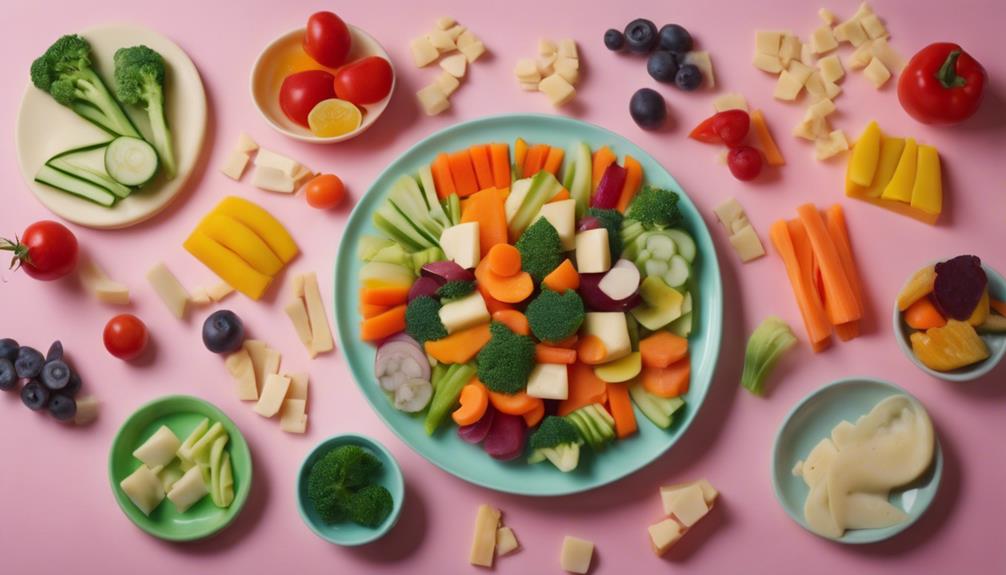
When it comes to introducing finger foods for independence to your little one, you're helping boost their self-feeding skills and encouraging exploration of different textures.
Bite-sized pieces of soft fruits, cooked veggies, and pasta can be great options to promote healthy snacking habits.
Don't forget to offer dips like hummus or yogurt to make the finger foods more appealing and add extra nutrition to your baby's diet.
Boosting Self-Feeding Skills
To enhance your baby's self-feeding skills, introduce finger foods that promote independence and hand-eye coordination. Finger foods play a vital role in developing your baby's ability to feed themselves and refine their motor skills.
Here are some suggestions to get you started:
- Banana Slices: Soft and easy to grasp, banana slices are perfect for little fingers learning to pick up food independently.
- Well-Cooked Pasta Pieces: Cooked until soft, pasta pieces provide a great opportunity for your baby to practice their hand-eye coordination while enjoying a tasty meal.
- O-Shaped Cereal: The familiar shape of O-shaped cereal makes it a fun and engaging option for babies to pick up and eat on their own.
Encouraging Exploration of Textures
Introduce a variety of textures through finger foods to encourage your baby's exploration and independence. Finger foods play an essential role in developing your baby's fine motor skills and fostering independence.
By offering a range of textures, you allow your little one to explore different sensations, aiding in their sensory development.
Soft cooked vegetables, fruits, and well-cooked pasta are excellent options for introducing finger foods. These foods provide varying textures that can help your baby learn to chew and manipulate food in their mouth.
Additionally, incorporating dips like hummus or guacamole can make finger foods more appealing and enjoyable for your baby.
Promoting Healthy Snacking
Encourage your baby's independence by offering healthy snacking options that promote self-feeding skills through finger foods. Introducing your little one to a variety of textures and tastes can enhance their palate and overall eating experience.
Consider these options to help your baby develop their self-feeding abilities:
- Banana Slices: Easy to grab and full of essential nutrients, banana slices are a great finger food for babies to practice their fine motor skills.
- O-shaped Oat Cereal: These cereals are perfect for tiny fingers to pick up and munch on, aiding in hand-eye coordination development.
- Bite-sized Pasta Pieces: Providing small pasta pieces encourages babies to use their pincer grasp, improving their self-feeding skills.
Remember to always supervise your baby when offering finger foods to prevent any choking hazards.
Safety Tips for Mealtime

When it comes to mealtime safety for your baby, it's important to prevent choking hazards.
Always supervise your little one closely during feeding to make sure they're eating safely and avoid any potential risks.
Remember to cut food into small, manageable pieces and steer clear of hard or sticky foods that could pose a choking threat.
Choking Hazard Prevention
To prevent choking hazards during mealtime, always avoid offering infants hard or crunchy foods like raw carrots.
When feeding your baby, it's important to take necessary precautions to guarantee their safety.
Here are some tips to help you prevent choking incidents:
- Cut foods into small, manageable pieces to reduce the risk of choking.
- Be cautious with small, round foods like grapes that can pose a choking hazard for babies.
- Supervise closely while your baby is eating to intervene promptly if needed.
Proper Food Temperature
Maintaining safe food temperatures is essential for guaranteeing mealtime safety and preventing foodborne illnesses. It's vital to serve hot foods at temperatures above 140°F to inhibit bacterial growth and cold foods below 40°F to reduce the risk of foodborne illnesses.
Using a food thermometer to check the internal temperature of foods, especially meat and poultry, is highly recommended to make sure they're cooked thoroughly. Leftovers should always be reheated to at least 165°F to make certain they're safe to consume.
Additionally, it's important to avoid leaving perishable foods, such as meat or dairy products, at room temperature for more than 2 hours to prevent spoilage and contamination.
Homemade Baby Food Essentials

Gather essential supplies like a food processor, cutting board, knife, spatula, spoon, and storage containers to start making homemade baby food. Having these items ready will make the process easy and efficient.
When preparing recipes for babies, using a food processor can help in blending and pureeing ingredients to a suitable consistency for your little one.
To make homemade baby food, you'll need to make sure you have the necessary ingredients like meat, veggies, fruit, fats, salt, and liquids. Combining these elements in the right proportions is vital to provide a balanced meal with proteins, fats, and carbohydrates for your baby's nutrition.
Remember to adjust the consistency of the homemade baby food by adding liquids such as water, bone broth, breast milk, or fermenting liquid. These additions can help tailor the food to suit your baby's preferences and stage of development.
Storing Homemade Baby Food
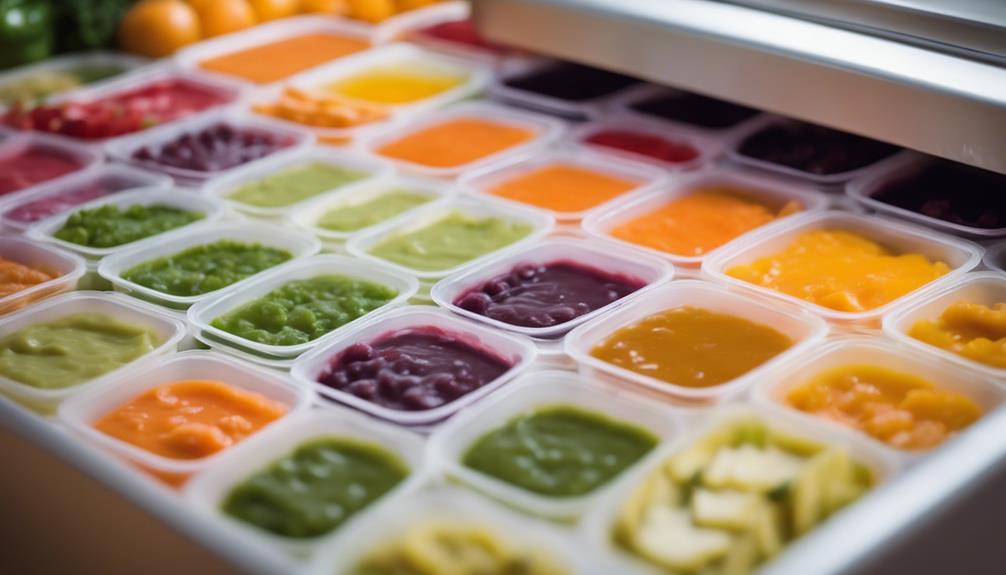
How can you guarantee the freshness and convenience of storing homemade baby food?
To maintain freshness and safety, refrigerate homemade baby food in a sealed container for up to three days.
For longer storage, freeze homemade baby food in ice cube trays for up to 3 months, allowing for convenient portioning.
Store unused homemade baby food in ice cube trays for quick and easy access to small portions when needed.
To thaw frozen baby food cubes, place them in the refrigerator overnight.
This method helps preserve the nutrients and ensures safe consumption for your baby.
Tips for Making Baby Food
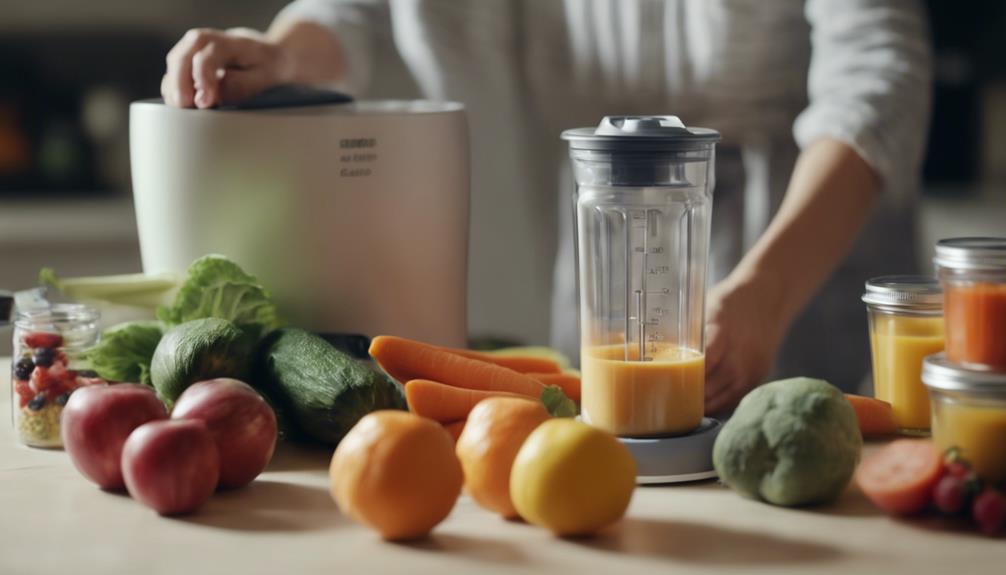
When preparing homemade baby food, prioritize using nutrient-dense ingredients like veggies and meats to guarantee your little one receives essential nutrients. To make the process smoother, here are some tips for crafting nutritious meals for your baby:
- Start with Soft or Pureed Foods: Begin with soft or pureed foods like sweet potatoes that are easy for babies to pick up and feed themselves.
- Adjust Consistency: Modify the texture of baby food by adding liquids such as water, breast milk, or bone broth to achieve the desired consistency.
- Storage Tips: Store homemade baby food in sealed containers in the fridge for up to three days. For longer storage, freeze unused portions in ice cube trays for up to three months.
These tips will help you create delicious and nutritious homemade baby food, ensuring your little one gets the best start with solid foods.
Frequently Asked Questions
What Is the Healthiest Way to Make Baby Food?
To make baby food healthily, you should use fresh, organic ingredients. Avoid chemicals by making it at home. Control ingredients to skip added sugars, salt, and preservatives. Steam or roast fruits and veggies for best nutrients.
What Are Easy Foods for Babies to Eat?
When it comes to feeding your little one, opt for soft, pureed foods like apple, avocado, and banana puree. These simple options make eating a breeze for babies, helping them grow strong and healthy.
What Are Healthy Eating Ideas for Babies?
When it comes to healthy eating ideas for babies, introduce nutrient-dense foods like veggies and meats for best growth. Start with homemade purees over commercial options and delay grains, refined sugar, and nuts until after the first birthday.
What Can Be Mixed With Baby's Regular Meals to Make Them More Nutritious?
To make baby's regular meals more nutritious, mix in pureed vegetables like spinach for a veggie boost. Add healthy fats such as avocado to aid growth. Incorporate proteins like pureed chicken for muscle development. Enhance iron intake with foods like pureed beef.
Conclusion
To sum up, homemade baby food recipes provide a simple and nutritious option for feeding your little one.
By starting with the best first foods and gradually introducing textures and flavors, you can help your baby develop healthy eating habits.
Remember to follow safety tips for mealtime and store homemade baby food properly.
With a little effort and preparation, you can guarantee your baby gets the best start to a lifetime of good nutrition.
So why not give it a try today?
Recipes
Dream of Eating Groundnut? What It Means for You!
Open the door to unlocking hidden meanings behind your dreams of eating groundnuts and discover how they can shape your well-being and growth!

Dreaming of eating groundnuts? Your subconscious might be nudging you towards prioritizing health, growth, and well-being in your life. These dream symbols could symbolize vitality and inner abundance. Positive aspects include joy and upcoming victories, while encountering rotten peanuts indicates potential dissatisfaction. Dream analysis offers valuable insights into desires and promotes personal growth. By understanding these messages, you can reveal hidden truths and empower personal development. So, next time you dream of munching on groundnuts, pay attention—your dreams may hold the keys to a healthier, fulfilling life!
Key Takeaways
- Symbolizes desire for health, growth, and wellness.
- Indicates need for balanced and healthy lifestyle.
- May hint at potential decline in health luck.
- Prepares for potential relationship challenges.
- Offers insights into personal growth and well-being.
Symbolism of Eating Ground Nuts
When dreaming of eating ground nuts, the symbolism often signifies a deep-rooted desire for health, growth, and overall wellness in your life. Your subconscious is highlighting the importance of prioritizing your well-being and nurturing your physical and mental health. It serves as a gentle nudge to pay attention to your body's needs and aim for a balanced and healthy lifestyle. So, next time you dream of indulging in these crunchy treats, consider how you can incorporate more nutritious foods and self-care practices into your daily routine.
Furthermore, the act of consuming roasted peanuts slowly in your dreams may hint at a potential decline in your health luck, reminding you to take proactive steps to safeguard your well-being.
Dreaming of eating dry peanuts could be your mind's way of preparing you for upcoming relationship challenges or obstacles on the horizon. Remember, dreams about collecting scattered ground nuts suggest a promising outlook for your health and overall abundance. Embrace the symbolism, and let it guide you towards a path of vitality and wellness.
Psychological Analysis of Dream Symbols

In delving into the psychological analysis of dream symbols, one can uncover profound insights into the subconscious mind's workings and the hidden meanings behind various dream elements.
Dreams of eating groundnuts, according to Compensation Theory, might indicate a deep-seated longing for recovery and revitalization. Teleology suggests that such dreams could be sending you messages about taking proactive steps towards your future. Archetypes reveal that groundnuts symbolize vitality, health, and growth in the dream domain.
If you find yourself collecting groundnuts in a dream, it may signify a subconscious desire for inner abundance and well-being. These unconscious messages involving groundnuts could be nudging you towards actions that lead to a healthier and more fulfilling life.
Positive and Negative Aspects

In conclusion, the dream of eating groundnuts reveals both positive and negative aspects that can offer valuable insights into your subconscious mind's messages. Dreaming of munching on groundnuts signifies joy, pleasure, and upcoming victories in your life. It's like a sneak peek into the happiness and success waiting for you around the corner.
On the flip side, encountering rotten peanuts in your dreams might indicate looming dissatisfaction or potential disappointment on the horizon. It's like a gentle reminder to stay vigilant and address any areas of concern before they escalate.
If you find yourself shelling groundnuts while dreaming, it could be your subconscious nudging you towards becoming more open and transparent in your relationships. However, spotting rotten peanuts in your dream serves as a cautionary sign of decay or negative changes heading your way.
Additionally, the act of buying peanuts in a dream often symbolizes the fulfillment of your needs and desires. So, pay attention to these dream details; they might hold the key to understanding your inner thoughts and emotions.
Importance of Dream Analysis

Understanding the importance of dream analysis can provide valuable insights into your subconscious mind's messages. Dream symbols, like eating groundnuts, hold significance that can unlock hidden meanings within your psyche. By paying attention to your dreams and delving into their analysis, you can unravel the mysteries of your innermost desires and needs. This self-reflection not only aids in personal growth but also promotes overall well-being. Through dream analysis, you can start recognizing patterns in your thoughts and emotions, gaining a deeper understanding of yourself.
| Importance of Dream Analysis | |
|---|---|
| Insights into Subconscious | Recognition of Patterns |
| Symbolic Meanings | Personal Growth |
| Self-Reflection | Well-being |
| Understanding Desires | Emotional Awareness |
| Promoting Self-awareness | Psychological Development |
Self-Understanding Through Dream Interpretation

Beginning the exploration of self-understanding through dream interpretation enables you to delve into the depths of your subconscious mind and uncover hidden truths about yourself.
Dreams of eating groundnuts hold symbolic meanings that can reveal your desires for health, growth, and wellness in various aspects of your life. By analyzing these dreams, you gain valuable insights into your mental, emotional, and physical needs, fostering a deeper understanding of yourself.
Paying attention to dream symbols, such as groundnuts, allows you to recognize your innermost desires and aspirations that mightn't be consciously acknowledged.
Dream interpretation serves as a powerful tool for personal growth, as it reveals hidden messages and provides guidance towards overall well-being. Understanding the significance of eating groundnuts in your dreams empowers you to navigate through your subconscious thoughts and emotions with clarity.
Embrace this journey of self-discovery through dream analysis, and discover the potential for profound self-understanding and growth.
Frequently Asked Questions
What Is the Meaning of Eating Groundnuts in Dreams?
When you dream of eating groundnuts, it symbolizes a subconscious desire for health and well-being. Tasting roasted peanuts slowly may indicate a potential decline in health luck, while collecting scattered groundnuts signifies improving health and abundance.
What Is the Spiritual Power of Groundnut?
Groundnut's spiritual power lies in grounding energy, nurturing the soul, and symbolizing abundance. It offers stability and nourishment, reminding you to seek spiritual growth, inner strength, and balance in life to embrace the universe's abundance.
What Does It Mean When You Dream About Eating Nuts?
When you dream about eating nuts, it signifies desires for health, growth, or satisfaction. The act symbolizes pleasure, anticipation, or intimacy. Different forms may represent aspects of health or relationships. Details reveal insights into well-being and desires.
What Do Peanuts Represent in Dreams?
Peanuts in dreams symbolize desires for health, growth, and wellness. Eating groundnuts may represent anticipation of relationship issues or sexual desires. They reflect feelings about physical health, nutritional status, and well-being, signifying improving health and abundance.
Conclusion
So, next time you dream of munching on groundnuts, remember that it might symbolize your desire for nourishment and security. Dive deeper into the meaning behind this dream to uncover hidden emotions and thoughts that could be guiding you in your waking life.
Dream analysis may seem like a quirky hobby, but it can offer valuable insights into your subconscious mind. Who knew a simple snack could reveal so much about your inner world?
Keep dreaming, keep exploring, and keep snacking!
Recipes
Date Paste Recipe: Natural Sweetener for Baby Foods!
Find out how to make a natural sweetener for baby foods with this easy date paste recipe – a healthy and delicious alternative to refined sugar!

Looking to sweeten your baby's food naturally? Whip up some date paste for a healthy and delicious touch! Soak soft dates in hot water, blend with water for a smooth paste, and store in the fridge. Start with 1-2 teaspoons for babies, adjusting gradually. Beyond baby food, use date paste in baking, as a glaze, or in dressings. Blend pitted dates with hot water, adjusting for consistency. Engage with the community for tips and flavor enhancements. For a versatile and refined-sugar-free option, try date paste over syrup. Sweeten up your baby's meals with this tasty alternative!
Key Takeaways
- Soak Medjool dates in hot water for rich sweetness.
- Blend soaked dates with water for smooth paste texture.
- Start babies with 1-2 teaspoons, gradually increasing.
- Use date paste as natural sweetener in baby foods.
- Label and store date paste in airtight container in fridge.
Preparation Tips for Date Paste
Soaking your soft dates in hot water is an essential step in preparing Date Paste. Opt for Medjool dates for a rich, caramel-like sweetness. The soaking time can vary based on the type of dates you have. Whether it's an overnight soak or just 10 minutes in warm water, the goal is to soften the dates for blending.
Once soaked, toss them into a blender with water to create a smooth Date Paste. For larger batches, start with 1 cup of dates, adjusting the water to achieve your desired consistency. This natural sweetener not only adds a lovely flavor to your baby foods but also provides essential nutrients.
When it comes to storage, keep your Date Paste fresh by refrigerating it for a couple of weeks. If you've made a big batch, Date Paste freezes beautifully for up to 6 months. Get ready to sweeten those baby foods with this delicious and nutritious paste!
Storage Guidelines for Date Paste
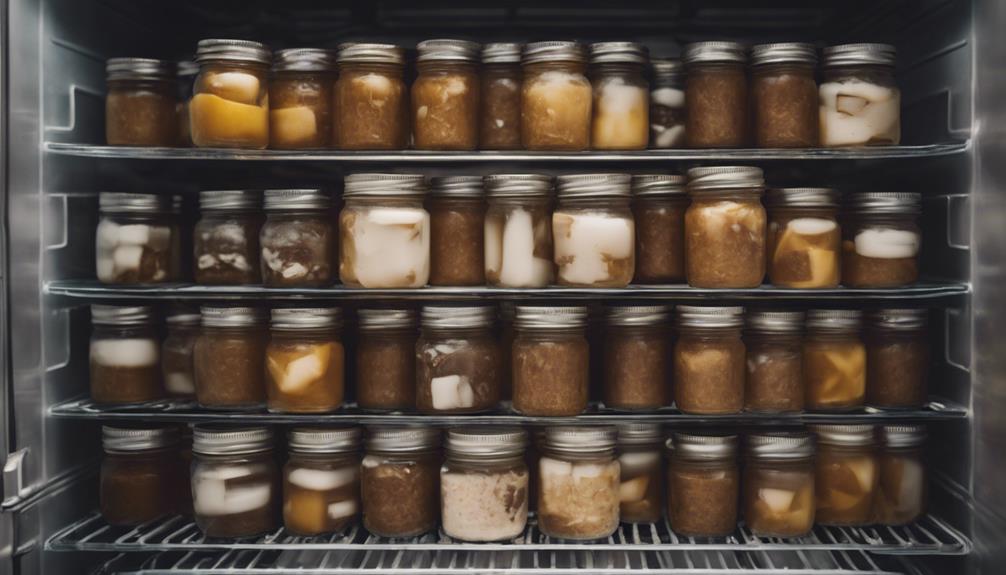
Consider storing your date paste in the refrigerator for several weeks in an airtight container to maintain its freshness and quality. For longer-term storage, freezing date paste for up to 6 months is also an option.
Here are some guidelines to guarantee your date paste stays fresh and safe for consumption:
- Use an airtight container: Seal your date paste in a container to prevent air exposure, which can lead to spoilage.
- Label with preparation date: Keeping track of when you made the date paste helps you know its freshness and usage timeline.
- Check for spoilage: Before using stored date paste, inspect for any signs of spoilage such as mold, off-smell, or unusual texture to ensure safety.
Date Paste Quantity for Babies
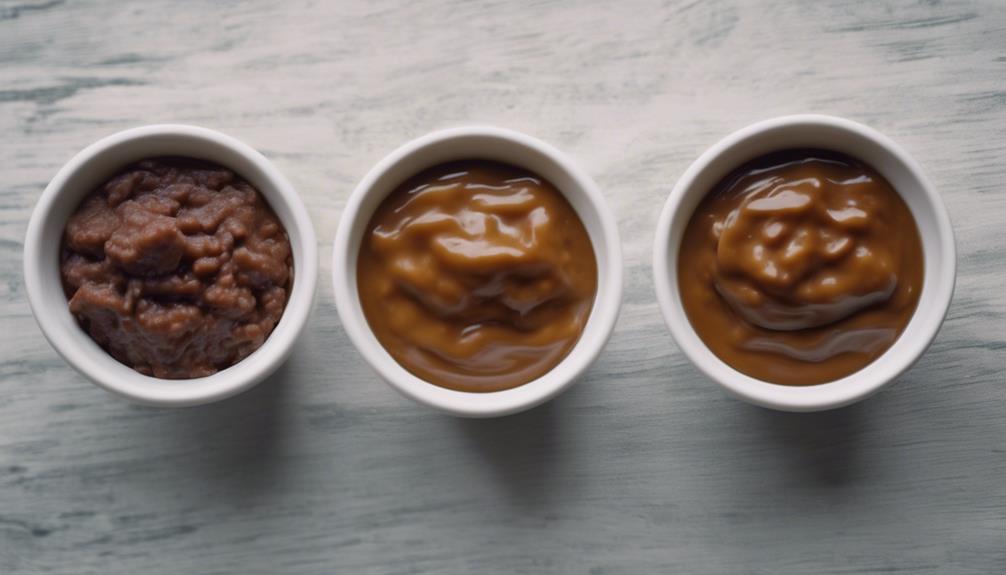
When feeding your little one date paste, remember to start small with just 1-2 teaspoons to gauge their reaction.
Slowly increase the quantity as they grow and develop a taste for it.
It's all about age-appropriate portion control to make sure they enjoy the benefits without overdoing it!
Serving Size for Babies
For babies, determining the appropriate serving size of date paste starts with introducing 1-2 teaspoons initially. Date paste can be a delightful natural sweetener to enhance the flavor and nutritional value of baby foods.
Here are some tips to help you navigate serving sizes for your little one:
- Start small: Begin with a conservative amount of 1-2 teaspoons to gauge your baby's tolerance and enjoyment of date paste.
- Gradual increase: As your baby grows and becomes accustomed to the taste and texture, you can gradually increase the quantity in their meals.
- Three-day rule: Remember to follow the three-day guideline when introducing date paste or any new food to make sure your baby doesn't have any allergic reactions.
Age-Appropriate Portion Control
Guarantee your baby's portion sizes of date paste align with their age and dietary needs by starting with 1-2 teaspoons as a guideline. When introducing date paste into your baby's diet, it's important to begin with a small amount to assess their tolerance and avoid any potential digestive issues.
Gradually increasing the quantity as your baby grows and shows no signs of intolerance is the best approach. Remember to follow the three-day rule when introducing new foods to watch out for any allergic reactions.
Date paste not only serves as a natural sweetener for baby foods but also enhances their flavor profile and boosts the nutritional value of the meals. While date paste is safe for babies when consumed in moderation, it's crucial to maintain portion control to ensure your little one receives a balanced diet.
Keep an eye on how your baby responds to date paste and adjust the portion sizes accordingly to support their healthy growth and development.
Alternate Uses of Date Paste

Looking to jazz up your recipes with a natural twist?
Date paste is your go-to ingredient!
From sweetening your morning pancakes to enhancing the flavor of your favorite desserts, date paste offers a versatile and healthy alternative to traditional sweeteners.
Get ready to elevate your cooking game with this simple yet impactful ingredient!
Recipe Versatility
Explore the various ways date paste can be creatively incorporated into different recipes to introduce natural sweetness and essential nutrients to your baby's diet.
Date paste isn't only a great sweetener for baby foods, but it can also be used in various other recipes to enhance flavors and provide healthy alternatives. Here are some exciting ways to utilize date paste:
- Spread it on dosas, pancakes, Chapati/roti, or bread for a natural sweet touch that toddlers and babies will love.
- Replace sugar in baking cakes, muffins, and cookies with date paste to create healthier snacks for your little ones.
- Elevate desserts like puddings, custards, and fruit salads by adding date paste for a mild, caramel-like sweetness while boosting the nutritional value of the treats.
Incorporating date paste into your recipes not only adds sweetness but also introduces fiber and essential nutrients to your baby's diet in a delicious way.
Sweetening Options
To diversify your baby's diet, consider incorporating date paste as a versatile sweetening option in various recipes beyond traditional baby foods. Date paste serves as a natural sweetener, offering a healthier choice compared to refined sugars. This versatile ingredient can enhance the flavor of purees, porridges, and other baby food recipes while ensuring optimal nutrition for your little one. Not only can date paste be used in baby foods, but it also makes a delicious spread for dosas, pancakes, Chapati/roti, or bread, adding a touch of sweetness to meals for both babies and toddlers. Additionally, you can substitute date paste for sugar in baking cakes and desserts for babies, introducing a natural and nutritious sweetness. By incorporating date paste into your baby's meals, you're not only providing a sweet flavor but also essential nutrients like fiber, iron, calcium, and potassium, promoting your child's overall health and well-being.
| Sweetening Option | Description | Usage |
|---|---|---|
| Date Paste Spread | A natural sweetener rich in essential nutrients | Spread on dosas, pancakes, Chapati/roti, or bread |
| Baking Substitute | Healthy alternative to refined sugars | Use in baking cakes and desserts for babies |
| Flavor Enhancer | Enhances taste without compromising on nutrition | Mix into purees and porridges for added sweetness |
| Nutrient Booster | Adds fiber, iron, calcium, and potassium | Incorporate into various baby food recipes |
Cooking Enhancements
Consider incorporating date paste into your cooking repertoire to elevate the flavors and nutritional value of your dishes. This versatile ingredient can be used beyond sweetening baby foods.
Here are some cooking enhancements you can explore with date paste:
- Use date paste to glaze roasted vegetables for a caramelized sweetness.
- Mix date paste into marinades for meats to add depth of flavor.
- Stir date paste into salad dressings for a hint of natural sweetness and richness.
Date Paste Recipe Details
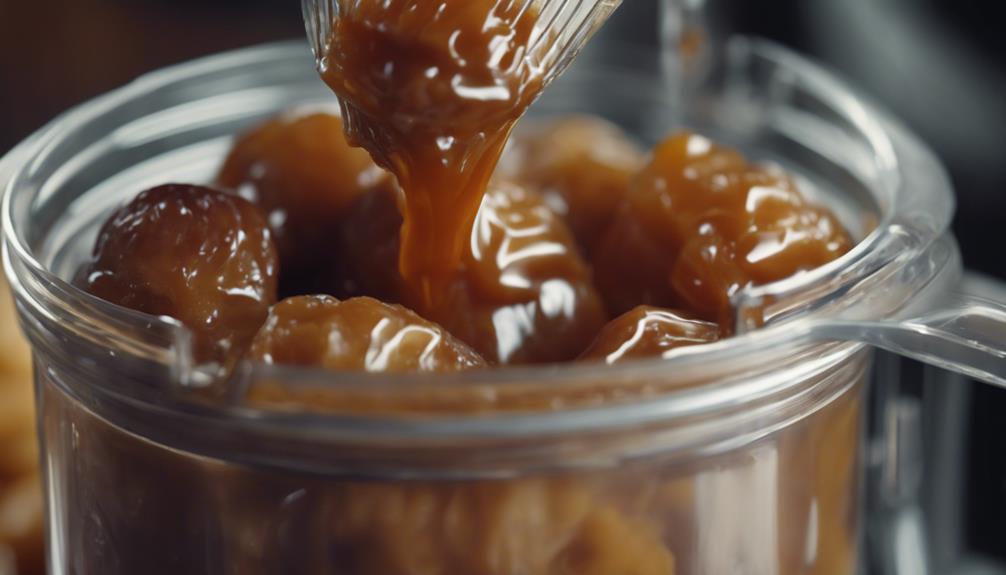
To guarantee the quality of your date paste, start by soaking whole or pitted dates in hot water to soften them before blending into a smooth puree. Make sure that your dates are free of pits to avoid damaging your blender. Use a powerful blender to achieve a silky texture that works well in various recipes.
Once blended, transfer the date paste into an airtight container for storage. When storing, refrigerate the paste for up to three months. If you want to keep it longer, consider freezing it for extended use.
Remember to check the consistency of your date paste before storing it. If it's too thick, you can add a bit of water and blend again until you reach the desired texture. Date paste is a versatile sweetener that can be used in a wide range of dishes, making it a handy ingredient to have on hand.
Now that you know the details of creating and storing date paste, you're ready to add this natural sweetener to your baby food recipes!
Feedback and Adjustments for Recipe

You may want to adjust the amount of hot water used in the recipe based on user feedback for best results.
Incorporating user feedback is crucial to enhancing the recipe for date paste. Here are some adjustments to contemplate based on user feedback:
- Opt for a gradual approach: Try adding the hot water gradually while blending the dates to achieve the desired consistency.
- Experiment with different ratios: Test varying amounts of hot water to find the perfect balance that suits your preference.
- Seek input from the community: Engage with other users to gather additional insights and tips for improving the recipe.
Date Paste Query: Paste Vs. Syrup
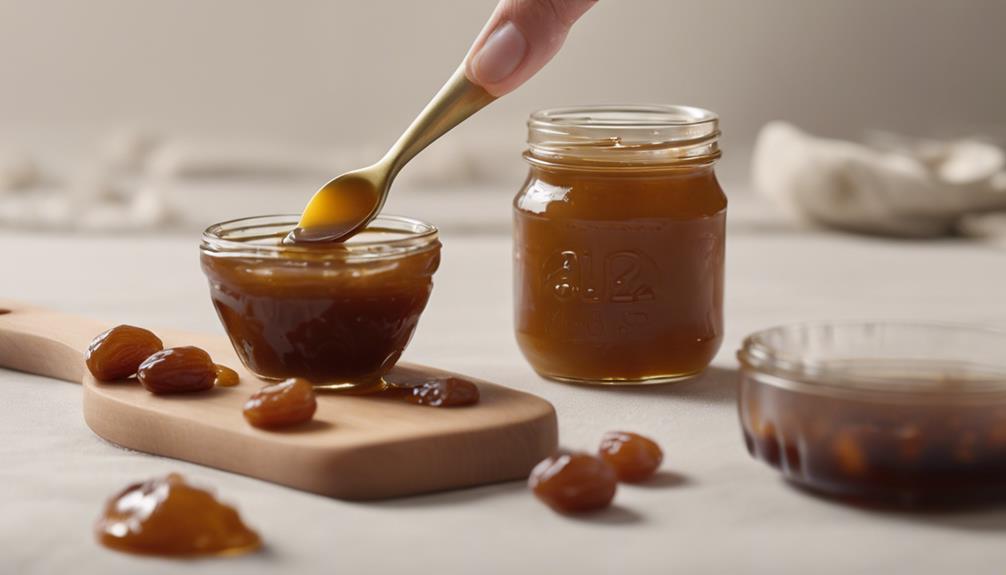
When deciding between date paste and syrup for baby foods, consider the different textures and applications each offers. Date paste serves as a natural sweetener, providing a healthy alternative to refined sugars. It boasts a thick, spreadable consistency, ideal for incorporating into various baby food recipes.
On the other hand, date syrup presents itself as a liquid sweetener, offering versatility in different culinary creations. If you prefer a pourable texture, you can easily convert date paste into a syrup by simmering it with water.
Both date paste and syrup can enhance the flavor of dishes without the need for refined sugars, making them excellent options for baby foods and beyond. Understanding the distinctions between the two allows you to experiment and find the perfect fit for your recipes.
Frequently Asked Questions
Can You Use Dates to Sweeten Baby Food?
You can use dates to sweeten baby food. Start with small amounts and increase gradually based on your baby's taste. Date paste is a healthy alternative to refined sugars, enhancing flavor and nutrition in baby purees, porridges, and snacks.
How Do You Use Dates as a Natural Sweetener?
To use dates as a natural sweetener, blend pitted dates with water to make date paste. Add this paste to baby porridges or purees for a sweet, nutrient-rich boost. Dates offer a healthy alternative to refined sugars in baby foods.
Can Babies Eat Date Paste?
Yes, babies can eat date paste. Start with small amounts, gradually increasing as they grow. Follow the three-day rule when introducing new foods like date paste to watch for allergies. It's a natural sweetener for baby foods!
How to Use Date Paste Instead of Sugar?
To use date paste instead of sugar, simply swap it in a 1:1 ratio in your baby food recipes. Enhance nutrition and sweetness effortlessly. Incorporate date paste into purees and porridges for a healthier alternative that provides essential nutrients.
Conclusion
So, there you have it – date paste isn't only a natural sweetener for baby foods, but it's also versatile and easy to make at home.
With the right preparation tips, storage guidelines, and quantity adjustments for babies, you can enjoy the benefits of this healthy alternative to refined sugars.
So go ahead, get creative in the kitchen and whip up a batch of date paste to sweeten up your little one's meals!
Recipes
Beet Puree for Baby: Nutritious and Vibrant First Food!
Boldly introduce your baby to the vibrant world of homemade beet puree, a nutritious and colorful first food that will nourish their taste buds and health!

Ready to explore the world of homemade baby food with beet puree? It's a vibrant and nutritious first food choice that will jazz up your baby's meals! Packed with essential vitamins and fiber for digestion, it's a colorful addition to your little one's diet. Simply roast, peel, and blend beets with fruits or veggies for extra flavor. Store in the fridge for a week or freeze in ice cube trays. Spice it up with cinnamon or ginger for added zest! Immerse yourself in the realm of homemade baby food with beet puree—it's a tasty, healthy treat that your little munchkin will love! Discover more beet-licious tips and tricks for your baby's meals.
Key Takeaways
- Nutrient-rich puree supports growth and immunity.
- Mix with fruits and veggies for variety.
- Provides essential fiber for digestion.
- Vibrant color adds mealtime excitement.
- Easy storage in fridge or freezer for convenience.
Why Choose Beet Puree for Babies
When introducing solid foods to your baby, opting for beet puree can be a nutritious and flavorful choice. Beets are nutrient-rich, packed with essential vitamins and minerals like calcium, folate, and Vitamin C, providing a wholesome start to your little one's culinary journey.
The versatility of beets allows you to mix them with other purees, introducing diverse flavors to your baby's palate early on.
Not only are beets delicious, but they also offer a healthy dose of fiber, which is important for aiding digestion and preventing constipation in infants. This makes beet puree a wise choice for supporting your baby's tummy health as they start solid foods.
Additionally, the immune-boosting properties of beets contribute to your baby's overall well-being, while the nutrients in beet puree support their growth and development.
In essence, beet puree isn't just a first food; it's a powerhouse of nutrition that can benefit your baby's health in multiple ways.
The Ingredients and Preparation
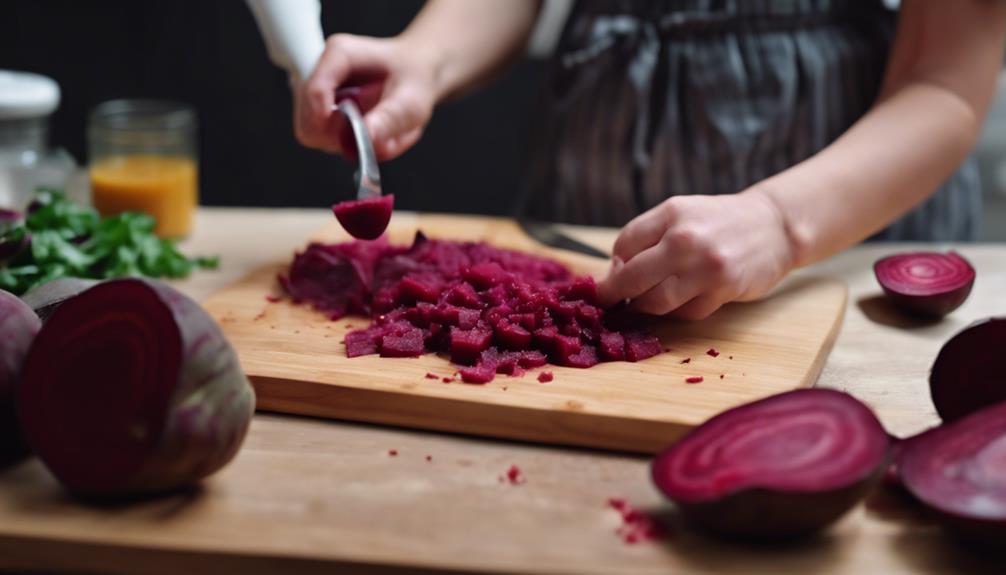
To create beet puree for your baby, start by roasting the beets until tender, then peel and puree them in a food processor. Beets are packed with essential nutrients like calcium, folate, and Vitamin C, making them an excellent choice for your little one's diet. Mixing beet puree with fruits such as applesauce or vegetables like butternut squash can introduce exciting flavors and variety to your baby's meals. When preparing beet puree, consider storing it in the fridge for up to 5 days for convenience or freeze it in ice cube trays for longer preservation.
| Ingredients | Preparation | Benefits |
|---|---|---|
| Beets | Roast until tender | Rich in nutrients |
| Food Processor | Peel and puree | High in Vitamin C |
| Ice Cube Trays | Store or freeze | Adds flavor variety |
Including beets in your baby's diet not only adds vibrant color but also contributes to their growth and immune support. Experiment with different combinations to find the perfect mix that your baby will love.
Making Beet Puree at Home

For a nutrient-rich and colorful addition to your baby's diet, consider making beet puree at home. Beets are packed with essential vitamins and minerals, making them an excellent choice for your little one's first food.
To make beet puree, start by roasting the beets in the oven until they're tender. Once cooked, peel the beets and blend them into a smooth puree using a food processor. You can get creative by mixing beet puree with other fruits and vegetables like applesauce, butternut squash, or broccoli to introduce different flavors and provide variety in your baby's meals.
When it comes to storage, store the beet puree in airtight containers in the fridge for up to 5 days. If you want to keep it longer, freeze the puree in ice cube trays for convenient portioning.
This homemade beet puree not only offers a burst of color and flavor but also delivers essential nutrients vital for your baby's growth, digestion, and immune system support. Get ready to introduce your little one to a vibrant world of nutritious goodness!
Tips and Serving Suggestions
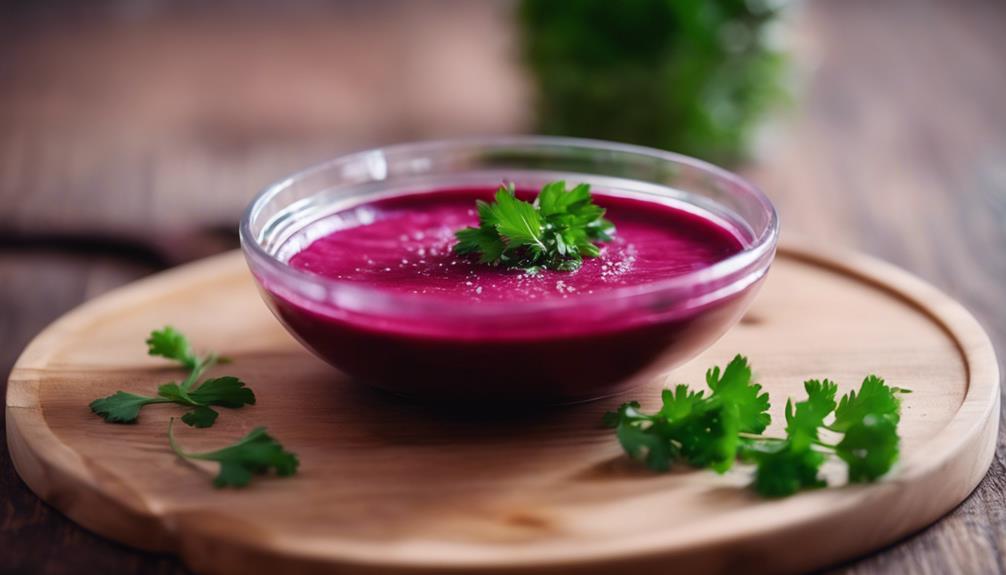
Consider enhancing your baby's beet puree by incorporating a variety of fruits and vegetables to introduce diverse flavors and textures. Mixing in ingredients like applesauce or butternut squash can not only add a twist to the taste but also provide additional nutrients for your little one's growth and development. Below are some creative serving suggestions to make mealtime enjoyable for your baby:
| Fruit Combos | Vegetable Additions | Spices |
|---|---|---|
| Pear | Sweet Potato | Cinnamon |
| Blueberries | Carrots | Ginger |
| Banana | Spinach | Nutmeg |
| Avocado | Zucchini | Cardamom |
Storage and Freezing Instructions
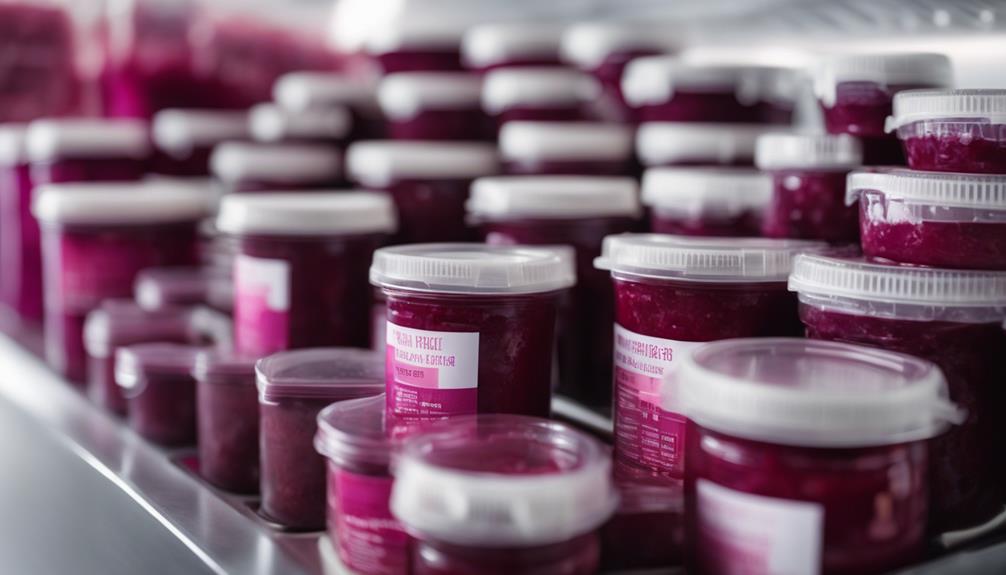
For best freshness, store beet puree in airtight containers in the fridge for up to 5 days.
When it comes to freezing, consider using ice cube trays for convenient portioning and storage lasting up to 3 months.
Thaw your frozen beet puree in the refrigerator or at room temperature before serving it to your little one.
To keep things organized, opt for labeled freezer bags to easily track when the puree was made.
Remember to cut your beets into similar-sized pieces before cooking and blending for a smoother puree texture.
- Airtight containers in the fridge help maintain the vibrant color and nutrients.
- Ice cube trays make it simple to grab just the right amount when needed.
- Thawing in the refrigerator preserves the puree's texture and flavor.
- Labeled freezer bags prevent confusion and help you stay organized.
- Cutting beets into similar-sized pieces ensures even cooking and blending for a perfect consistency.
Frequently Asked Questions
Are Beets a Good First Baby Food?
Yes, beets are a fantastic first baby food choice! They offer a range of essential nutrients, support healthy digestion, and have a naturally sweet taste that babies love. You can easily mix beets with other purees for added nutrition.
How to Puree Beets for Babies?
To puree beets for babies, roast, peel, and blend them until smooth. Make sure they're cooked soft to avoid choking hazards. Mix with other fruits/veggies for tasty combos. Store and freeze for easy meals.
What Are the Benefits of Beetroot Puree?
Beetroot puree offers a wealth of benefits for your little one. Packed with essential nutrients, this vibrant puree aids digestion, supports immune health, and introduces delicious flavors. Easily made at home, it's a convenient choice for busy parents.
Is Raw Beetroot Safe for Babies?
You might wonder, is raw beetroot safe for babies? Yes, it is when prepared correctly. Grate or cook it until soft to avoid choking hazards. Introduce this vibrant veggie in ways that suit your little one's needs.
Conclusion
To sum up, beet puree is a nutritious and vibrant first food option for your little one. Packed with essential nutrients and easy to prepare, this colorful puree is sure to be a hit at mealtime.
So go ahead, whip up a batch of beet puree at home and watch as your baby enjoys every spoonful of this delicious and healthy treat!
Happy feeding!
-

 Activities and Learning4 months ago
Activities and Learning4 months agoEngage Quiet Students With Interactive Quiz Apps
-

 Vetted4 months ago
Vetted4 months ago9 Best Personalized Father's Day Gifts for Your Husband – Thoughtful and Unique Ideas
-

 Activities and Learning4 months ago
Activities and Learning4 months agoAvelox: A Prescription-Free Risk
-

 Activities and Learning4 months ago
Activities and Learning4 months agoActive Forum Requires User Interaction for Access
-

 General Tips4 months ago
General Tips4 months agoStruggling Mom Quotes: Words of Hope and Encouragement!
-

 Activities and Learning4 months ago
Activities and Learning4 months agoRobaxin: CVS Orders, Renal Health Caution
-

 Activities and Learning4 months ago
Activities and Learning4 months agoGet Levaquin: Treat Infections & Stay Safe
-

 Activities and Learning4 months ago
Activities and Learning4 months agoCabaser: Risks, Alternatives, and Gambling Concerns




































